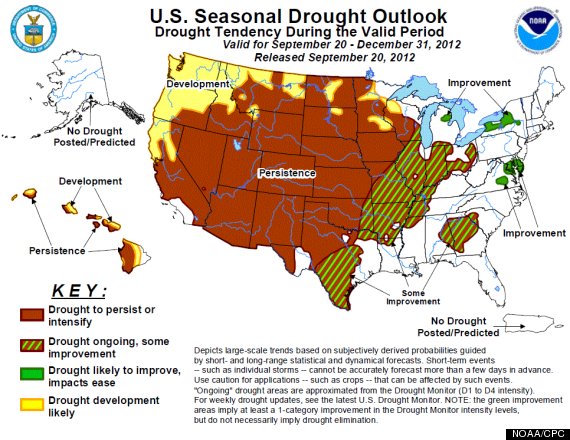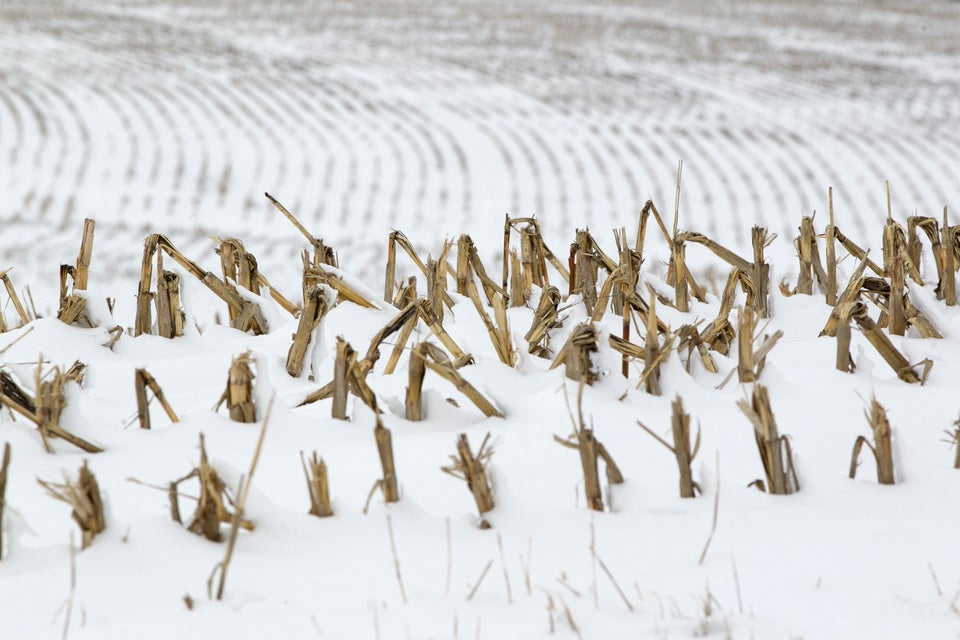The massive and widespread 2012 drought that has gripped the nation since the spring refuses to die, according to the latest report from the U.S. Drought Monitor — and in fact, it’s expanded a little: as of September 18, 64.82 percent of the contiguous U.S. was suffering from at least moderate drought, slightly more than the 64.16 percent reported a week earlier, enough of a gain to set a new record for this drought category.

The seasonal drought outlook issued September 20, 2012.
At the same time, NOAA released its seasonal drought outlook for the period ending December 31, and it offers little prospect for significant improvement. Drought is projected to persist in a huge swath of the country, especially in the West from Southern California to West Texas, north to Wisconsin, and back west to Montana, Idaho, southeastern Oregon and back down to Nevada — and everywhere in between.
In addition, drought conditions are projected to develop during the period in the rest of the Pacific Northwest and Upper Midwest. A small swath from south Texas up through Indiana and parts of Ohio may see “some improvement” in drought conditions, as might parts of Alabama, Georgia and South Carolina. The rest of the East and Southeast are mostly unaffected by drought at this time, and that is projected to continue.
The drought forecast for the next few months is being shaped by the expected influence of a developing El Niño event in the equatorial tropical Pacific Ocean. Such events are characterized by warmer than average sea surface temperatures, which can profoundly reshape weather patterns in the U.S. and elsewhere. El Niño winters tend to be wetter than average in the South and the Ohio Valley.
In a conference call with reporters on Thursday, Hugh van den Dool, a climate forecaster with NOAA’s Climate Prediction Center, said El Niño conditions are not developing quickly, and is likely to be modest in strength.
“We believe there will be an El Niño,” van den Dool said, “but the strength of it is debatable, and it may be a fairly weak one.” He said water temperatures halted their increase during September, and this may prevent a strong El Niño event from occurring. “We expect this will intensify a little bit as we get into later fall, but it is probably too late to get a major El Niño.”
The Climate Prediction Center’s forecasts show above average temperatures are likely across the northern tier of the country through December. As is typical during El Niño winters, the southern tier of the country is forecast to have above average precipitation through December, particularly the Gulf Coast region from Texas to Florida.
As for what’s going on currently, if you include slightly less severe “abnormally dry,” category, the percentage of the Lower 48 rated as drier than normal leaps to a whopping 78.15 percent, although that represents an (infinitesimal) retreat from the previous week’s 78.53 percent.
For the most severe category, “exceptional drought,” the new number is 5.96 percent of the lower 48, down from 6.26 percent the previous week, and if you add the second most severe, “extreme drought,” the total for both categories are now 20.74 percent, down from the previous week’s 21.09.
The drought is the worst to strike the U.S. since the Dust Bowl era of the 1930s and lengthy droughts of the 1950s. It came on suddenly and largely without warning, and although the main trigger was most likely water temperatures in the Pacific and Atlantic Oceans, the drought was exacerbated by extremely hot temperatures during the spring and summer. July, for example, was the hottest month on record in the U.S., and the summer was the third-hottest on record, narrowly losing out to 2011 and 1936. Climate studies have shown that the odds of severe heat waves are increasing due to manmade climate change.
According to the Drought Monitor, areas of moderate drought expanded in the upper Midwest, in the states of Minnesota, Wisconsin and the Dakotas. In Kansas, the overall situation improved slightly, with areas in exceptional drought shrinking nearly ten percentage points, from 60.61 to 51.05. Overall, however, the entire state remains in severe drought or worse.
In other states, changes were relatively small overall, although narrow areas with some states did have significant changes. Heavy rains in southern and eastern Nevada, for example, pushed some parts of the state from severe down to moderate drought conditions.
